Quick Answer: You should water your snake plant (Sansevieria trifasciata) only when the soil is completely dry. For most indoor environments, this means watering every 2 to 8 weeks. However, the exact frequency depends heavily on factors like light, temperature, pot size, and the season. Always check the soil moisture before watering; it’s far better to underwater than to overwater a snake plant.
The snake plant is celebrated for its resilience and striking, architectural leaves. It’s a favorite among both new and seasoned plant enthusiasts for its low-maintenance reputation. Yet, many well-intentioned owners find their beloved plant suffering from yellowing leaves and mushy stems. The culprit is almost always the same: improper watering. The most common question we hear is, “How often do I water my snake plant?” The answer is simpler and less frequent than most people assume.
Mastering the art of watering your snake plant isn’t about adhering to a strict schedule. It’s about learning to read your plant’s needs and understanding its environment. These plants are native to arid regions of Africa and Asia, meaning they are built to withstand drought, not deluges. This guide will walk you through every aspect of watering, from identifying the signs of thirst to choosing the right soil, ensuring your snake plant not only survives but thrives for years to come.
Why the Question “How Often to Water a Snake Plant” Is So Critical
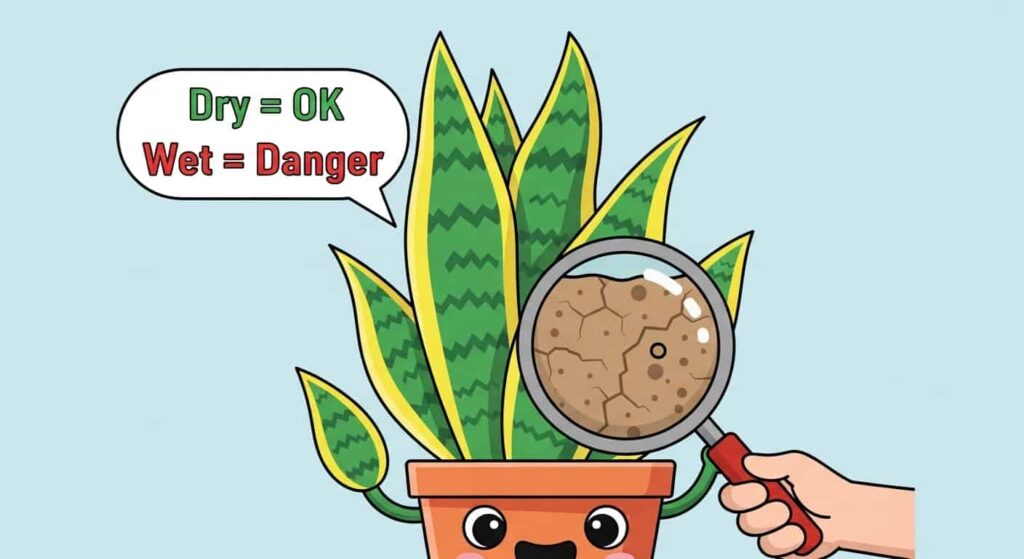
Understanding when to water your snake plant can be the difference between a healthy, thriving specimen and a plant headed for the compost bin. A single, ill-timed watering can spell disaster. Snake plants have evolved to store water in their thick, succulent leaves, a trait that allows them to endure long periods of drought. Their root systems, however, are not equipped to handle constant moisture.
The most significant danger to a snake plant is root rot. This condition occurs when the soil remains waterlogged for too long, depriving the roots of oxygen and creating a breeding ground for fungi. Once root rot sets in, it can quickly spread, turning the roots brown and mushy and eventually killing the entire plant.
This is why a “set it and forget it” watering schedule often fails. A plant that needs water every two weeks in the bright, warm days of summer might only need it once every two months during the dormant winter period. Learning to assess the plant’s actual needs, rather than watering by the calendar, is the single most important skill for any snake plant owner. It’s not about the date; it’s about the dirt.
How to Tell if a Snake Plant Needs Water: Your 7-Step Checklist
Instead of guessing, use these proven methods to determine precisely when it’s time to give your snake plant a drink. This approach removes all uncertainty and protects your plant from the dangers of overwatering.
1. The Finger Test: Your Most Reliable Tool
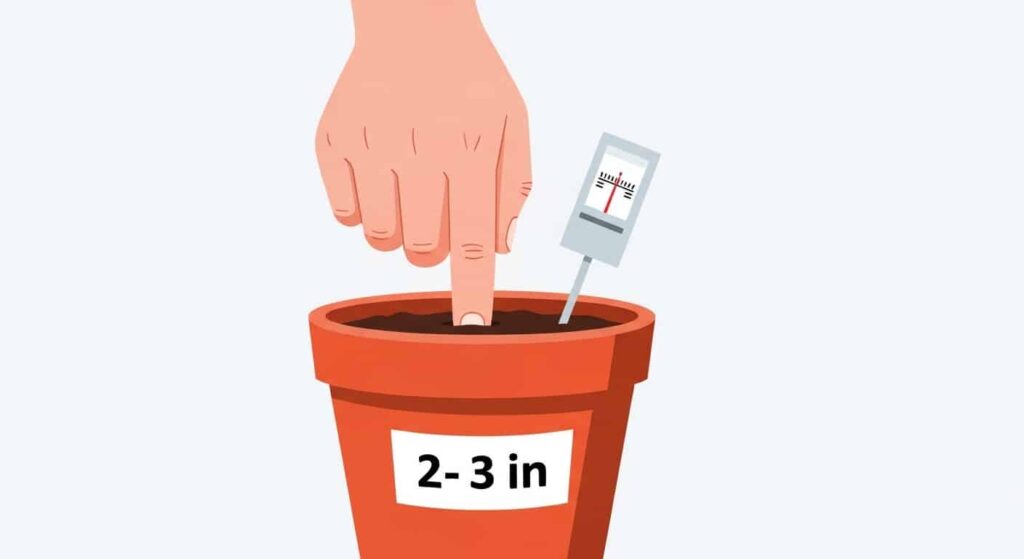
The easiest and most effective way to check for moisture is to use your finger. This tactile method gives you a direct reading of the soil conditions where it matters most—around the roots.
To perform the test, simply insert your index finger about 2 to 3 inches (5-8 cm) deep into the soil. If the soil feels dry to the touch at that depth, it’s time to water. If you feel any moisture or coolness, wait longer. Don’t be tempted to water just because the top layer looks dry; the soil deeper in the pot can still be wet. For larger pots, you may need to check even deeper. This simple habit is the best way to answer the question, “How often to water a snake plant indoors?”
2. Observe the Soil’s Appearance
Dry soil often looks different from wet soil. It may appear lighter in color and can sometimes pull away from the sides of the pot. When the soil has shrunk and created a gap around the edge, it’s a clear sign that it has completely dried out and is ready for a thorough watering.
3. Lift the Pot
A pot with dry soil is significantly lighter than one with moist soil. Get into the habit of lifting your snake plant’s pot right after you’ve watered it and then again a week or two later. Over time, you’ll develop a feel for its weight. When the pot feels noticeably light, it’s a good indicator that the soil has dried out and your plant may be thirsty. This is especially useful for smaller pots.
4. Check the Drainage Holes
Another simple trick is to look at the drainage holes at the bottom of the pot. If the soil visible through the holes looks and feels dry, it’s a strong sign that the entire root ball has dried out. Conversely, if you see dark, damp soil, you know there is still plenty of moisture available to the roots.
5. Use a Moisture Meter
For those who prefer a more technical approach, a soil moisture meter can be a valuable tool. These inexpensive devices have a probe that you insert into the soil, providing a reading on a scale from “dry” to “wet.” For a snake plant, you should only water when the meter registers firmly in the “dry” range. This takes the guesswork out of the equation and provides an objective measure of the soil’s moisture level.
6. Look for Subtle Leaf Cues
A healthy, well-watered snake plant has firm, upright leaves. While you want to avoid letting the plant get to this stage, an underwatered snake plant may show subtle signs of thirst. The leaves might start to look slightly wrinkled or less plump, and the tips may begin to curl inward. These are late-stage indicators, so it’s better to rely on soil checks, but they can confirm that your plant is ready for a drink.
7. Consider the Season and Environment
The needs of your plant change dramatically throughout the year. During the active growing season of spring and summer, increased light and warmth mean the plant uses water more quickly. In contrast, during the fall and winter, growth slows, and the soil stays moist for much longer. Always factor the season into your assessment.
Seasonal Watering Guide: Adjusting to Your Plant’s Rhythm
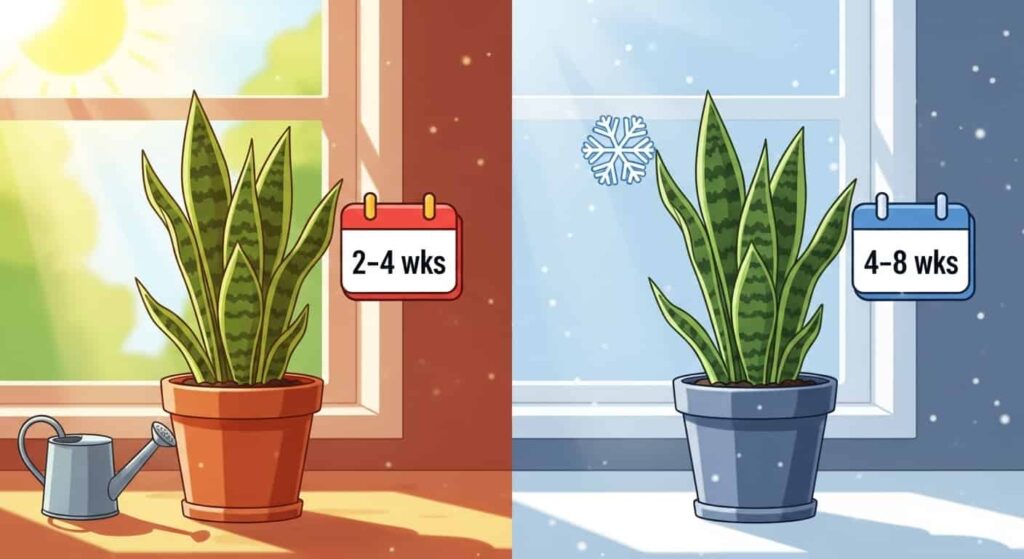
Your snake plant’s watering needs are not static. They follow a natural rhythm dictated by the changing seasons, light levels, and temperatures. Adjusting your care routine accordingly is essential for its long-term health.
How Often to Water a Snake Plant in Summer and Spring
During the active growing period of spring and summer, your snake plant is busiest. Longer days and warmer temperatures fuel photosynthesis and growth, causing the plant to use water more quickly.
During these months, you may need to water your snake plant every 2 to 4 weeks. However, this is just a guideline. The rule remains the same: always check the soil first. If you live in a particularly hot or dry climate, or if your plant is in a very bright spot, you may find yourself watering on the more frequent end of this spectrum. A plant in a cooler, less sunny room will need water less often, even in summer.
How Often to Water a Snake Plant in Winter and Fall
As the days shorten and temperatures drop in fall and winter, your snake plant enters a period of dormancy. Its growth slows down significantly, and its need for water decreases dramatically. This is the most dangerous time for overwatering.
During the fall and winter, reduce your watering frequency to once every 4 to 8 weeks, or even less. In very low-light conditions, a snake plant might go for more than two months without needing water. The combination of cold temperatures and wet soil is a death sentence for snake plant roots. When in doubt during winter, always wait longer. Let the soil dry out completely and stay dry for a week or two before you even consider watering.
The Right Way to Water: Top vs. Bottom Watering
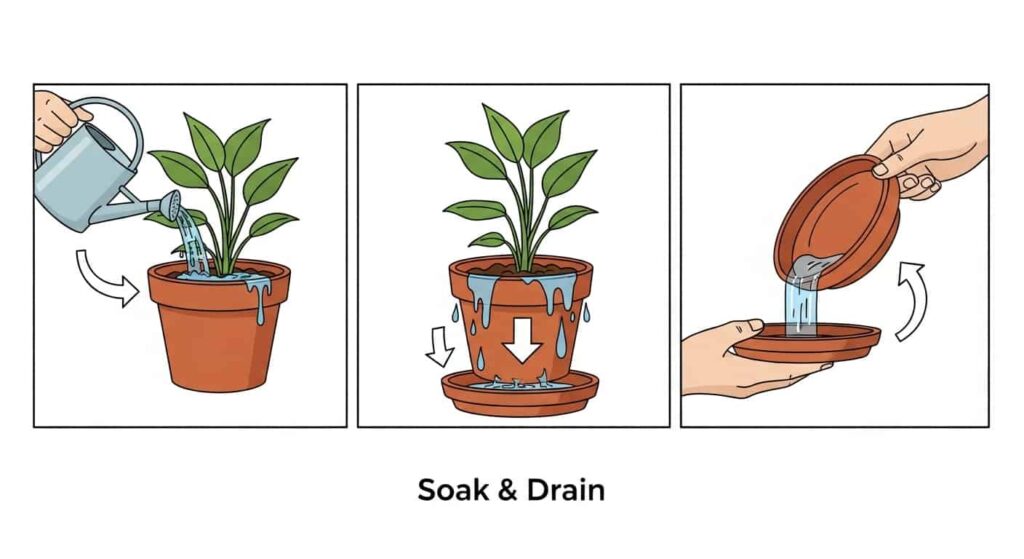
Once you’ve determined it’s time to water, the method you use is just as important as the frequency. The goal is to moisten the entire root ball evenly without leaving the plant sitting in stagnant water.
Do You Water a Snake Plant from the Top or Bottom?
Both top and bottom watering are effective methods, and the best choice often depends on your plant’s specific situation.
Top Watering: The Soak-and-Drain Method
This is the most common watering technique. When you water from the top, pour water slowly and evenly over the entire soil surface until it begins to flow freely from the pot’s drainage holes. This ensures that all the roots have access to moisture.
After watering, allow the pot to drain completely for 10-15 minutes. It is absolutely crucial to discard any excess water that collects in the saucer or cachepot. Never let your snake plant sit in a puddle of water, as this will suffocate the roots and lead directly to root rot.
Bottom Watering: For Deep Hydration
Bottom watering is an excellent method, especially if the soil has become so dry that it has started to pull away from the pot’s sides (becoming hydrophobic). In this state, water poured on top can run straight down the gap without soaking the root ball.
To the bottom water, place the pot in a sink or basin filled with a few inches of water. Let the plant sit for 15-30 minutes, allowing the soil to absorb water up through the drainage holes via capillary action. You’ll know it’s done when the top surface of the soil feels moist. Once finished, remove the pot from the basin and let it drain completely before returning it to its spot.
Environmental Factors That Influence Watering Frequency
No two homes are the same, and even different rooms within the same house can present unique environments. Several key factors will influence how often you water your snake plant indoors.
- Light: A snake plant in a bright, sunny window will photosynthesize more and use water much faster than one in a dim corner. More light means more frequent watering.
- Temperature: Warmer air increases the rate of evaporation from the soil and transpiration from the leaves. Plants in warm rooms will need water more often than those in cool rooms.
- Humidity: In a humid environment (like a bathroom), the soil will retain moisture for longer. In a dry, air-conditioned home, it will dry out much faster.
- Pot Size and Material: The type of pot you use has a significant impact. Small pots dry out faster than large ones. Terracotta and other unglazed clay pots are porous and allow moisture to evaporate through their walls, meaning the soil dries out more quickly. Plastic and glazed ceramic pots are non-porous and hold moisture for much longer.
- Soil Type: Snake plants require a draining soil mix. A dense, heavy potting soil will retain too much water and compact around the roots. Using a gritty, well-aerating mix designed for cacti and succulents is ideal. You can also amend standard potting soil with perlite, pumice, or sand to improve its drainage.
- Plant Size: This brings us to the question, how much to water a large snake plant? A large, mature plant with an extensive root system will naturally use more water than a small, young one. However, it’s also likely to be in a larger pot that holds more soil and moisture. The principles remain the same: water thoroughly but only when the soil is dry. A large plant simply needs a greater volume of water to saturate its root ball, not necessarily more frequent watering.
Rescuing an Overwatered Snake Plant
Even with the best intentions, mistakes can happen. If you notice yellowing leaves, a soft or mushy base, or a foul odor coming from the soil, you may be dealing with root rot. Act quickly to save your plant.
- Remove and Inspect: Carefully take the snake plant out of its pot. Gently shake off the old, wet soil to expose the root system.
- Assess the Damage: Healthy roots are firm and white or light tan. Rotted roots will be brown or black, mushy, and may fall apart when touched.
- Prune the Rot: Using a clean, sharp pair of scissors or a knife, trim away all of the affected roots. Be thorough; any remaining rot can spread to the healthy roots. If much of the root system is gone, you may also need to prune some of the leaves to reduce the burden on the remaining roots.
- Let it Air Dry: If the remaining roots are still very damp, you can let the plant sit out in a dry, shaded area for a day to allow the cuts to callus over and the root system to dry slightly.
- Repot: Repot the snake plant in a clean pot with fresh, fast-draining soil. Do not use the old, contaminated soil. Choose a pot that is appropriately sized for the remaining root ball; a pot that’s too large will hold excess moisture.
- Water Sparingly: Wait at least a week before watering your repotted snake plant. When you water, do so lightly. Give the plant time to recover and grow new roots before resuming a normal watering routine.
Conclusion: Your Simple Path to a Happy Snake Plant
The secret to a thriving snake plant is refreshingly simple: neglect it a little. These tough, adaptable plants prefer to be left alone rather than fussed over. When it comes to the question of how often to water a snake plant, the answer lies not in a calendar but in your fingertips.
By committing to one simple habit—checking that the soil is thoroughly dry before you even think about reaching for the watering can—you eliminate the number one threat to your plant’s health. Combine this with a pot that has good drainage and a gritty soil mix, and you’ve created the perfect environment for your Sansevieria to flourish. Embrace the “less is more” philosophy, and your snake plant will reward you with years of effortless beauty.
Frequently Asked Questions (FAQs)
How often should I water my snake plant in winter?
In winter, you should water your snake plant much less frequently, typically every 4 to 8 weeks. Its growth slows, and it uses very little water. Always let the soil dry out completely between waterings.
How do I know if my snake plant needs water?
The best way to tell if a snake plant needs water is to stick your finger 2-3 inches into the soil. If it feels dry at that depth, it’s time to water. Other signs include very light pot weight and soil pulling away from the pot’s edges.
Can a snake plant sit in water?
No, a snake plant should never be left sitting in water. This is the fastest way to cause root rot. Always empty the drainage saucer after watering.
What do the leaves of an overwatered snake plant look like?
Overwatered snake plant leaves often turn yellow, become soft and mushy (especially near the base), and may fall over. You might also notice a rotten smell from the soil.
How does a terracotta pot affect watering frequency?
Terracotta pots are porous and allow soil to dry out much faster than plastic or glazed pots. You will likely need to water a snake plant in terracotta more often, but always check the soil first.
Is bottom watering better for a snake plant?
Both top and bottom watering work well. Bottom watering is particularly useful if the soil has become very compacted or dry, as it ensures the entire root ball gets hydrated. The key for both methods is to allow the pot to drain completely afterward.

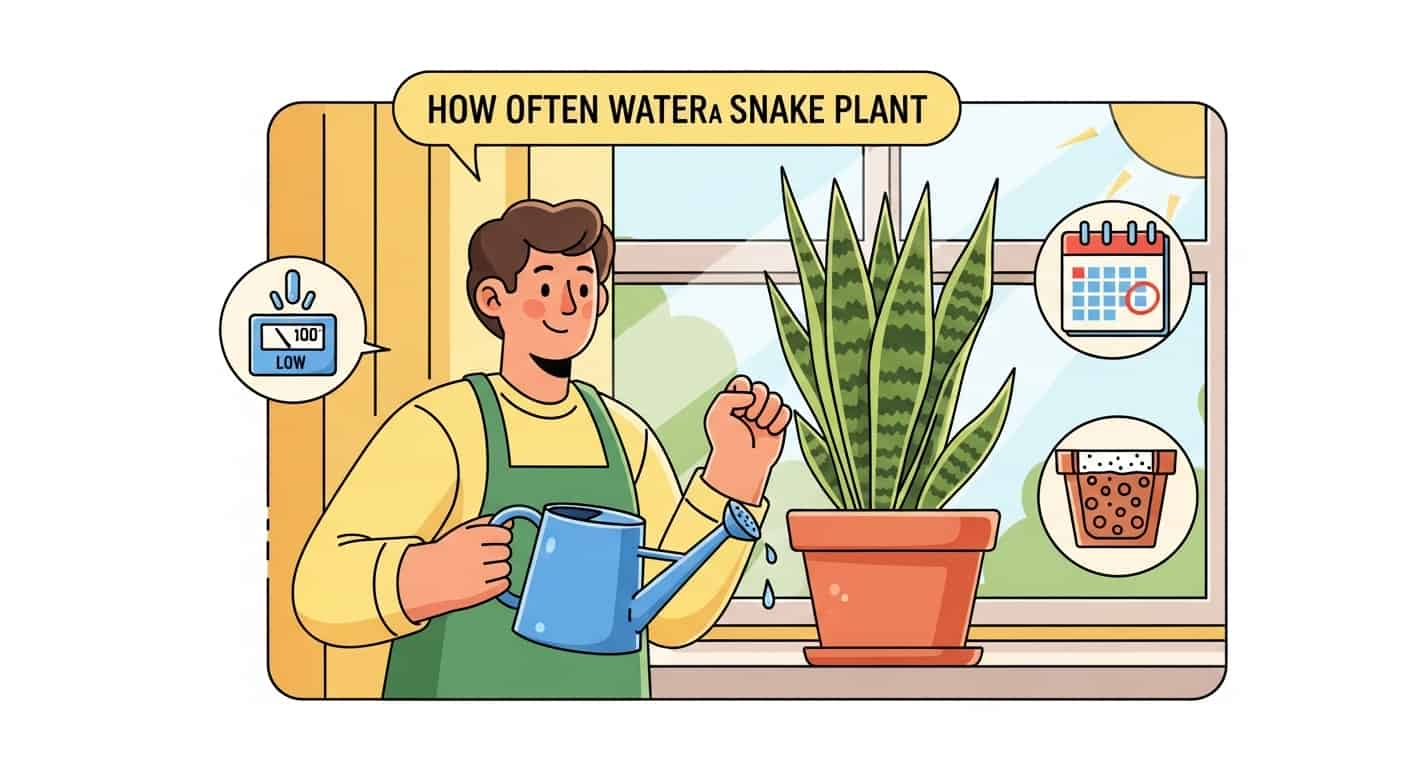
Leave a Reply to How Fast Do Snake Plants Grow: 11 Amazing Growth Facts That’ll Speed Your Success – Indoor Plant Nook Cancel reply